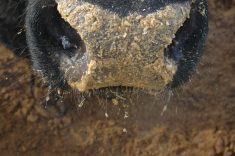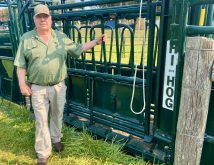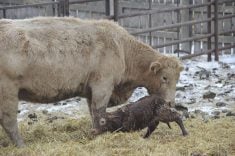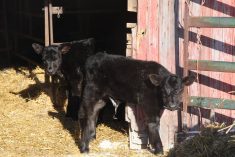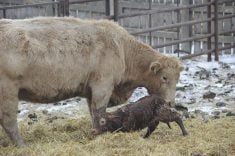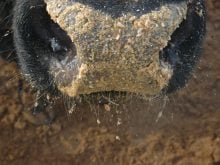Most cattle have lower than usual supplies of vitamin A because of the drought, so producers should consider supplements
Cattle are at higher risk of vitamin A deficiency due to last year’s drought and related shortage of green grass.
Dr. Cheryl Waldner, Beef Cattle Research Council chair at the Western College of Veterinary Medicine, says cattle with access to green pasture can readily obtain about four months worth of vitamin A, stored in the liver, which the body can utilize.
“Green grass contains hundreds of times more carotene than harvested feeds,” she says.
Because pastures were very dry last year, most cattle have lower than usual supplies of vitamin A so producers should consider supplements.
Read Also

Beef cattle more prone to trace mineral deficiencies
The trace mineral status of our cows and calves is a significant challenge for western Canadian producers and veterinarians.
“It’s important to read labels and talk to your veterinarian and nutritionist, however, and give proper amounts. You don’t want to double up vitamin A sources or injections,” says Waldner.
“If you are supplementing in a mixed ration, take care with measurements and thorough mixing. Too much vitamin A is toxic because it is fat-soluble and stored in the liver.
“We need to be careful about dosage, but many cows require supplementation because they didn’t see much green grass last summer and fall. They would have been running short within months after they grazed the last of the green grass last season.
“If the cows are short, their calves will also be short. Cows may be slow to rebreed and there is also more risk of sickness and mortality in the calves,” says Waldner.
Field research from Western Canada has shown higher death losses in calves that are deficient in the first week after birth.
Many commercial supplements contain vitamin A, but when this vitamin is mixed with trace minerals, it is not stable.
“It’s an easy way to get it into the cows, eating it with the mineral/salt mix, but it needs to be relatively fresh. You don’t want it sitting for more than three or four months before they consume it,” says Waldner.
“The most important time to get vitamin A into cows is during the last two or three months before calving, but also important between calving and the start of breeding season if the cows don’t have access to green grass. Hopefully we’ll have more rain this spring and have some green grass.”
Even so, it’s important not to oversupply this nutrient.
“Vitamin A is also important for calves and not just the cows. If the cows didn’t have supplement through winter, giving a vitamin injection at the time of their pre-calving vaccination could help make sure the cows’ colostrum will have enough vitamin A. It can be more difficult to inject these vitamins during cold weather, however, because it’s thick and even thicker when cold.”
Supplementing cows in their ration is ideal, she adds, “but use of injections in calves at birth is a common and effective method to ensure they have a good start.”
Vitamin E is also likely to be in short supply due to drought last year. These two vitamins work together, as do vitamin E and selenium. If cows are on green grass this spring, they can quickly overcome deficiencies in vitamins A and E.
In average years, feeds grown on fertile soils and grazed or harvested at optimum times usually provide all the vitamins and minerals cattle need.
But some soils are short on various minerals or contain excess elements that tie up important trace minerals.
If several animals in a herd have health problems, poor fertility, poor response to vaccination or slow growth, a trace mineral deficiency may be suspected. Blood samples, liver biopsies or urine samples can confirm it. Such samples are usually adequate to measure most mineral levels, though illness may skew the results.
Diarrhea, acidosis, stress, fever or trauma can alter concentrations of certain minerals in body fluids and tissues.
It is important to test several animals in the herd, not just a sick one. Ten animals or 10 percent of the herd, whichever is most logical, is recommended for accurate assessments. There can be a lot of individual variation in cattle, so there must be enough samples to get a true picture of the herd’s mineral status.
Dr. Gregory Penner, professor and Centennial Enhancement Chair in Ruminant Nutritional Physiology at the University of Saskatchewan, says trace mineral requirements of cattle are not fully met by forages or other feeds. Plants grown in soils deficient in certain minerals will also be deficient. Some soils are short on selenium or copper, for instance.
“This is why we provide mineral supplements. We can also have a situation where some feeds influence absorption (or) availability of other minerals,” he says.
For example, molybdenum will tie up copper. Feed or water high in sulfur ties up other essential minerals including copper. Chronic exposure to high sulfur in the diet has an adverse effect on ruminants, often inducing copper deficiency.
“Another problem with water sources high in sulfur is that the water contains more total dissolved solids and is also high in sodium,” says Penner.
“When we provide minerals to cattle as a free-choice mix with loose salt, the salt is what entices them to eat it.”
If cattle are getting lots of sodium in the water, they may not consume the salt-mineral mix and then don’t get the needed trace minerals. Sulfates also tie up any trace minerals they get in feed.
Penner says there are many options when it comes to supplements and a primary goal is to ensure cattle eat enough of it.
There are several forms of trace minerals.
“Some are classified as inorganic and are not as readily absorbed and utilized by the body. The ones we typically classed as organic we now call enhanced availability. They have less solubility/activity in the rumen and more in the intestine.
“These are classified as chelated minerals and there is also a new group called hydroxy trace minerals, which seem to have promise as being readily available.”
Cattle can be injected or given boluses to provide the needed minerals.
“The challenge with slow-release boluses is that you could still have the same issue with dietary contaminants like high-sulfate water or high-sulfur feeds,” notes Penner.
“Sulfates could still bind with and tie up the trace minerals so they are poorly absorbed. Boluses address the supply issue but it doesn’t address the interaction with other minerals.
“There is data to suggest that the minerals that are more available in the intestine rather than the rumen probably help reduce the risk for dietary interactions from feed or water.”
Many vitamins, such as vitamin E and carotene, are provided in forage. Water-soluble B vitamins are synthesized by rumen microbes and do not need to be added to feed for mature animals.
Baby calves don’t have a functioning rumen with microbes and can’t synthesize vitamin B or K, but all the necessary vitamins are provided by the colostrum of cows that have adequate vitamin levels.
Vitamin D is obtained naturally when cattle are outdoors in the sunlight, allowing for natural production. Vitamin E is important for a healthy immune system and muscle function.
Vitamin A is also important to the immune system and healthy tissues. Beta-carotene, the precursor to vitamin A, is plentiful in green forages, so cattle are never short of this vitamin if they graze green pasture during summer.



